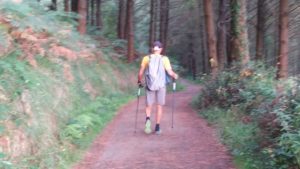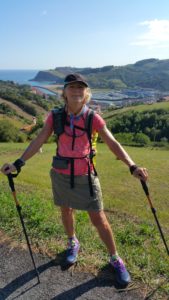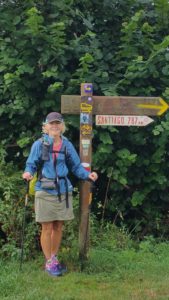At some point, perhaps when we get back, I’ll go through an extensive list of what equipment we brought, why we brought it and didn’t bring other items, why we made the specific brand/type selections, etc. It’s a long story, and interesting story (for some), but not the story for today.
So, what’s needed? I’ll divide it into five categories: shoes, clothes, poles, pack and purpose. My belief is that most of us (me, at the front of the line) over-think the first four items, and don’t spend nearly enough time on the last time.
Shoes: Shoes are vital. Room for your feet to swell (they will) is critical. Comfortable and dry socks are necessary. Beyond that, it’s really just “stuff”. We opt for trail running shoes (Brooks Cascadia’s), which many of the Pacific Crest Trail hikers use, but it isn’t necessary. Kit Carson didn’t have a membership to Zappo’s to get his trail running shoes overnighted to him! Comfortable and dry … key.
Clothes: You need to be warm when it’s cold and cool when it’s hot. Forget the fashion statements. You’ll do laundry every evening, so selection is never the challenge (hmm, I think I’ll wear what I wore today!). Keep a sharp eye on the weight, though. Synthetics are both effective and light-weight. Down is great for warmth and low weight.
Pack: In my efforts to get the “best possible”, I purchased Mountain Laurel Designs Ultra-lightweight packs, weighing about 14 oz. Is that the best? Not really. What works for you is the best. My father used to take an old cotton sleeping bag, put all his gear in it, roll it up longitudinally, bend it into a “horse-shoe” shape, tie it off and sling it over his shoulder. Done! His backpack effectively weighted “ZERO” ounces. Just make sure yours is comfortable.
Poles: In prior years of hiking, I eschewed poles … for old people! We used poles on our last Camino and I swear by them now! (And not just because I’m now “old”!). Poles used properly take 5 – 15% of the load off your feet and that’s just enough to prevent most of the repetitive injuries that come from day-after-day-after-day abuse. Don’t leave home without them! What type? John Muir used a stick. Really, that’s fine. We use Komperdell Vario 4 poles, as they are light (carbon fiber), adjustable, and collapse easily into a suitcase. But really, you can use anything.
Purpose: This is an area where most of us (including Diane and I) don’t spend enough time on. The romantic notion of hiking through fields of wheat, or forests, along rivers, etc. will honestly give way to the realities of blistered feet, aching knees, and just “I’m tired of abusing myself” attitudes … unless you are clear in your purpose. You need something that carries you through the “this wasn’t in the guidebook” moments. Like hiking for hour after hour through mud that adds 2 pounds per shoe and simply won’t go away. Like finding out that the town that was supposed to be ‘just around the corner’ is actually six more miles away … and you’ve already got 16 miles in that day. Like, missing your home, your family, your own bed.
For some, the purpose is simply the challenge; can I do it? Great for you, when you complete it! For some, it’s the history; there’s over 1,000 years of history on this Camino. Seeing and imaging what it was like for pilgrims 1,000 years ago is fascinating. For some, it’s the social scene. Yes, there is a social scene, though at this social scene, everybody goes to bed about 9:30 pm because they’re beat! For some, it’s an opportunity to connect with your Creator. Sometimes, in our very controlled lives in ‘civilization’ there’s not that opportunity to step back, breathe and have that talk with God that’s been on your mind for some time.
Now, if you haven’t really figured out your purpose for doing the Camino, don’t worry. You’ll have plenty of time while on the Camino. Life at 3 mph kind of changes your perspectives!
Buen Camino.


 Apparently, this was to control the erosion from the earlier straight up and down trail that is a long side these wooden staircases.
Apparently, this was to control the erosion from the earlier straight up and down trail that is a long side these wooden staircases.

 No getting lost here!
No getting lost here!








 it is amazing how cheerful we can be when we haven’t started the work.
it is amazing how cheerful we can be when we haven’t started the work.
 Once appropriately attired, we thoroughly enjoyed the hike. After 11 miles we arrived in Pasaia where we enjoyed a wonderful lunch of anchovies and clams.
Once appropriately attired, we thoroughly enjoyed the hike. After 11 miles we arrived in Pasaia where we enjoyed a wonderful lunch of anchovies and clams.
 We are now in the process of our daily routine, washing ourselves, our clothes, and exploring a new town.
We are now in the process of our daily routine, washing ourselves, our clothes, and exploring a new town.